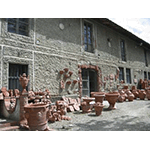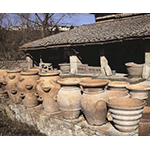The kilns of Impruneta
A town of ancient origins, Impruneta boasts an important tradition in the manufacturing sphere linked to the exploitation of the numerous clay quarries present in the territory. The high quality of the material, which confers on the finished product an excellent degree of strength and lightness, the abundance of wood to fire the kilns and the nearness of such a great, important centre as Florence have contributed since the Middle Ages to the development of craftsmen's activities specialised in the production of tiles and vases used for storage (urns). Testifying to the importance assumed by Impruneta's production in the 14th and 15th centuries there exist, among the abundant records and architectural evidence, two exemplary cases: a document dating from the year 1308, according to the Florentine calendar ab incarnatione, which attests to the presence of a guild of pitcher-makers and jar-makers at Impruneta ("artis mezzinariorum et urceorum plebatus Sancte Marie Impinete") and a Vita di Filippo Brunelleschi (Life of Filippo Brunelleschi) written by Antonio Manetti, which records how the famous Florentine architect personally supervised the production of roofing tiles in the kilns of Impruneta that were to be used in building the Dome of Santa Maria del Fiore. It was during this time, moreover, that we see an increase in the requests for supplies of crockery from the Florentine hospitals, pharmacies and monasteries, a service that was to continue also in the following centuries in parallel with the growing success of a new production of ornamental terracottas for the embellishment of gardens.
Of this glorious past there remain today numerous kilns, still in operation, which conserve their original structure and some of their ancient equipment. Especially noteworthy among these are the kiln of the Poggi family, dating from the late 16th century, with its typical loggia standing before the courtyard in which the terracotta products were placed to dry during warm weather; the Mital, with its collection of ancient products, the F.lli Masini kiln, which conserves two furnaces dating from the late 18th century and the nineteenth-century gesso models of the earlier proprietors; and lastly, the Agresti Kiln. The latter complex, built in the early years of the 18th century and now abandoned for some years, has conserved its original layout on two floors built of stone and bricks, with the two ancient wood-burning furnaces, the place in which the bundles of wood were stored, consisting of a fine structure with arches, and the loggia with a broad farmyard in front of it. To keep the premises intact and ensure a good state of conservation, it has been proposed to salvage the area within the context of a Town Administration project for establishing a Documentation Centre for Impruneto Terracotta.
****************************
Texts by Elena Fani
English translation by Catherine Frost
Last update 03/gen/2008





